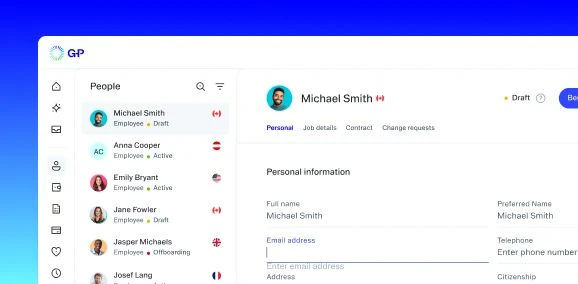The EU Pay Transparency Directive is a landmark legislation slated to redefine gender pay equality across workplaces in the EU. The Directive is a true milestone in the journey towards gender pay equality and fairness for workers that aims to reduce the gender pay gap by improving pay transparency and increasing reporting obligations.
To prepare for these new regulations, companies across the EU need to understand the challenges, implications, and opportunities that the Pay Transparency Directive will bring to the employment market. At a recent webinar G-P hosted with ADP and Blick Rothenberg, panelists Stuart Hyland, Partner at Blick Rothenberg, and Meg Ferrero, VP, Assistant General Counsel at ADP, discussed some of the key aspects of the Directive and explored its potential impact on companies and workers. We’ve recapped some of the Directive’s most pressing issues to help companies prepare to meet new stronger pay reporting requirements and other benchmarks mandated by the legislation.

- Develop a data infrastructure to meet pay reporting requirements.
- Use data analytics to streamline pay reporting.
- Implement an education plan around pay transparency and equity for employees.
- Keep accurate records and documentation on how salary, bonuses, and total rewards compensation decisions are made.
- Act quickly and conduct a readiness assessment to identify the first line of action.

#1 The Pay Transparency Directive will require companies to conduct gender pay gap analyses and report their gender pay gaps.
To conduct a pay gap analysis and report on gender pay gaps, companies can start by collecting and analyzing relevant data on employee salaries, bonuses, and benefits to identify any gender disparities. Implementing analytical job evaluation systems and salary structures will be needed to help ensure equal pay for equal work. An example of this is implementing salary banding or ranges for each job position or grade/level companywide. By establishing clear and standardized salary bands based on job size, HR teams can ensure every employee is equitably compensated.
ADP’s Meg Ferrero advised that regular review and adjustment of salary bands based on market trends and internal equity considerations will help companies be more proactive in bridging pay gaps. “For pay equity policies, make sure you’re documenting your pay ranges for your positions and your roles, and the process and analysis that was related to those pay ranges being set so that you can refer back to those and have the documentation to support the decisions that were made,” Ferrero shared. Bonuses and total rewards reporting will also be key moving forward, as companies need to be transparent about how these performance incentives are awarded across roles and genders.
Companies will have to publish large chunks of their reward strategy and make them available to employees because you have to share information on how pay is set, how it is managed, and progressed, and this isn’t just base pay, it’s across the reward spe
Stuart Hyland
Partner, Blick Rothenberg
#2 If the gender pay gap exceeds 5%, companies must conduct a joint pay assessment with workers’ representatives.
In addressing gender pay gaps exceeding 5%, companies must develop a comprehensive roadmap that combines data-driven strategies with proactive measures to promote pay equity and gender equality. “The employer must share information on how pay is set, managed, and progressed with each employee, and the criteria must be objective and gender neutral,” said Hyland.
The first step is to conduct a thorough analysis of salary data to understand the origin and cause of gender pay gaps: What are the policies and procedures for salary setting and how might these be communicated across the organization to create more equity and opportunity? Having a documented roadmap helps teams pinpoint some common issues that should be addressed when trying to achieve pay equity, including:
- Occupational separation, where one gender is disproportionately represented in lower or higher paying roles.
- Disparities in career progression and promotion opportunities, where one gender is considered more frequently.
- Lack of transparency in salary structures and pay decisions across the organization.
#3 Data analytics tools will be key to streamline pay reporting and guide implementation strategies for the Directive.
Implementing the EU Pay Transparency Directive means companies need a strategic approach that involves thorough data analysis and reporting mechanisms. Companies can leverage data analytics tools to streamline pay reporting by centralizing salary data, conducting regular pay audits, and identifying disparities in compensation. Additionally, data analytics tools can provide valuable insights into pay structures, trends, and inform corrective action to ensure compliance with the Directive’s transparency requirements.
Beyond the requirements for employers that are federal contractors, there’s no federal law in the U.S. for pay transparency. The current trend is for the states to adopt their own versions. We’re also seeing developments related to requirements that comp
Meg Ferrero
VP, Assistant General Counsel, ADP
#4 An education plan around pay transparency can facilitate successful implementation of the Directive.
Education and impact sessions for HR teams and executive leadership should focus on explaining the Directive’s requirements, such as mandatory pay gap reporting, employee access to pay information, and measures to address pay disparity. Hyland advises companies to highlight the implications for compliance, potential legal risks, and the benefits of fostering a transparent pay culture. “This will be a full culture change, and not just a practice change, for companies,” said Hyland.
Manage top global talent and ensure ongoing compliance with G-P.
Staying on top of evolving regulations is crucial for smooth operations and growth. To learn how your company can get ahead of the EU’s new pay transparency requirements, watch the full webinar on-demand .
Don’t let the stress of compliance slow down your plans for global growth. Our Employer of Record (EOR) solutions ensure ongoing compliance with evolving laws and regulations to mitigate risk and safeguard future success. For more information on how G-P can help you hire, onboard, and manage global teams in 180+ countries, quickly and compliantly, contact us today or book a demo.



















